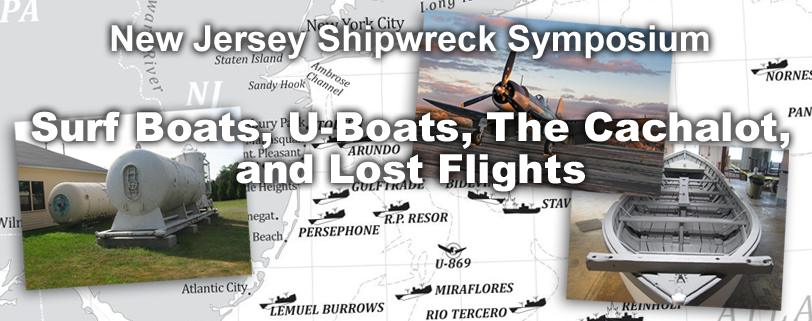Marconi Eras
Around-the-World Wireless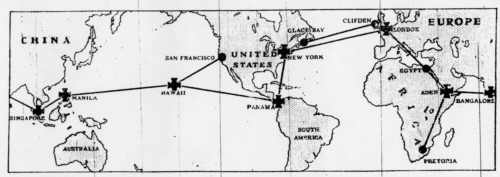
This is this first description of Marconi’s vision of a World Wide Wireless network built on nature’s ether. It includes cost justification and advantages over cable telegraph.
Popular Mechanics
September 1912, Page 331- 334
AROUND-THE-WORLD WIRELESS
By Frederick Minturn Sammis, Marconi’s Chief Engineer in America
Although wireless telegraphy is a comparatively new art and has grown prodigiously during the 15 years it has been in use, it may be said to be still in its infancy.
Within the last few months, plans have been consummated for completely encircling the earth with a great chain of high-power Marconi stations.
In 1901 Mr. Marconi had completed a station at Cornwall, England, which for those days was considered colossal. From this plant of a hundred horse-power, the initial experiments across the Atlantic were conducted. Marconi proceeded to Newfoundland and by means of a kite succeeded in elevating a copper wire to a considerable height and with this temporary receiving antenna, he was able to detect the now-famous letter “S,” that was being sent by the powerful transmitter in England. At Glace Bay, Nova Scotia. A powerful station was then erected and, after much testing and remodeling, was opened for commercial service for the past few years has worked daily across the 1,700 miles of ocean, with the station at Clifden, Ireland. An additional site has just been acquired a few miles from the present Glace Bay station in order to make possible the simultaneous transmission and reception of messages, thus duplexing the circuit and doubling its earning power. Further, the English government has arranged with Mr. Marconi to erect six high-power stations to be located in London, England; Cyprus, or Egypt; Aden, on the Red Sea; Bangalore, India; Pretoria, South Africa, and Singapore. The work of selecting the sites and the preparation of the huge quantity of material, consisting of masts, engines, and apparatus, has already begun and some idea of the magnitude of this work may be gained when it is considered that about 500 hp will be required to operate each of these stations and that, exclusive of land, buildings, and foundations for machinery, they will cost $300,000 for each station.
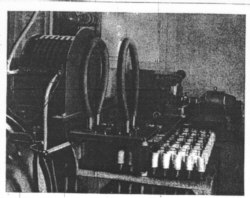 To the layman, a wireless station consists of a small and insignificant hut containing the wireless equipment and one or two masts or towers supporting the aerial wires, but it is probable that comparatively few readers have seen any of the really large Marconi transatlantic stations. These monuments of the inventive mind and untiring zeal of Guglielmo Marconi covers tracts of land over a mile on length upon which are erected a large number of huge steel masts which, in some instances, are 400 ft. high. The masts support a network of copper wires. These wires perform a dual function. When they are connected with the transmitting apparatus or spark gap they shake, with a mighty electrical force, the ether surrounding them and cause electromagnetic waves to become detached and travel away into space. When connected to the receiving apparatus they become the ear instead of the voice of the system and collect the vibrations that have been hurled into space at lightning speed by the distant station and lead them down to the sensitive receiving apparatus which corresponds to the drum of the human ear.
To the layman, a wireless station consists of a small and insignificant hut containing the wireless equipment and one or two masts or towers supporting the aerial wires, but it is probable that comparatively few readers have seen any of the really large Marconi transatlantic stations. These monuments of the inventive mind and untiring zeal of Guglielmo Marconi covers tracts of land over a mile on length upon which are erected a large number of huge steel masts which, in some instances, are 400 ft. high. The masts support a network of copper wires. These wires perform a dual function. When they are connected with the transmitting apparatus or spark gap they shake, with a mighty electrical force, the ether surrounding them and cause electromagnetic waves to become detached and travel away into space. When connected to the receiving apparatus they become the ear instead of the voice of the system and collect the vibrations that have been hurled into space at lightning speed by the distant station and lead them down to the sensitive receiving apparatus which corresponds to the drum of the human ear.
It has been found practicable, by arranging the aerial wires in a particular direction, to cause the waves to travel almost entirely toward one point, whereas the old method sent them out in all directions like waves caused by dropping a stone in the center of a pond. It will, of course, be evident that this improved method of working can only be utilized where fixed stations are concerned, and that ship stations and those shore stations that work with the ships must continue to use the original antenna, or aerial, that works equally well in all directions.
Until the present time, our country has not been entitled to boast of a real high-power station, but now plans have been finished that will place the United States in the first rank with respect to both size and number of these modern high-power stations, and which in conjunction with the stations being erected for the English government already referred to, will provide a commercial service that will encompass the earth. This station will be near New York City, at Belmar, N.J., where 500 acres of land have been acquired upon which the masts and plants will be erected. Transmission will be effected to the Panama Canal Zone and thence to Hawaii.
The Hawaiian station will be one of the most powerful of the entire group, for besides communicating with the station at Panama, it will be capable of working with San Francisco and the Philippine Islands, and with a station to be erected later in New Zealand. The Manila station is the last of the American group and will connect to the east with the Singapore station of the English group. Unbroken communication will be maintained successively through the stations at Bangalore and Aden. At the later station, we may turn southward over the huge mountains of Abyssinia and the wilds of German East Africa. It is probable that the station at Pretoria will be called upon to communicate with the proposed high-power station at Buenos Ayres, soon to be started.
Retracing our steps to Aden on the Red Sea, we may talk with the station in Egypt to the north, and thence, by one tremendous leap, hurl a message with such force that it will cross the wide Mediterranean, ascend the boot of Italy, scale the ice-crowned Alps and drop quietly into London, all in less than two-thousandth of one minute. Having arrived in England, we may take the present busy route from Clifden, Ireland, to Glace Bay, Nova Scotia, in order to talk with our Canadian neighbor, or we may utilize the new and more powerful station at London. By this means we arrive once more at our starting point at Belmar. Thus with but nine stepping stones, we may trip around the earth. Still further stations are contemplated: in fact, the chain that girdles the globe will be but the main artery of a great system. Feeders and branch stations will be established in all countries and a very comprehensive chain will be erected in South America in the near future.
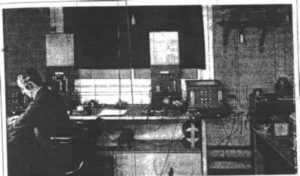 With the establishment of this great network of stations will come an era of cheap communication, for wireless telegraphy may easily reduce the present cable rates. The cost of a submarine cable to cover a distance of 3,000 miles is anywhere from $7,000,000 to $10,000,000, while the total cost of a pair of wireless stations to do the same work is but $600,000. The cable must handle a half-million dollars worth of business in order to earn enough to keep it in repair, while two percent of this amount will take care of the same item for the wireless. Two million words at 25 cents a word will earn only a sufficient sum to cover depreciation of the cable, while the same number of words at half rate by wireless will produce enough to pay the depreciation charge and 35 percent on the investment besides.
With the establishment of this great network of stations will come an era of cheap communication, for wireless telegraphy may easily reduce the present cable rates. The cost of a submarine cable to cover a distance of 3,000 miles is anywhere from $7,000,000 to $10,000,000, while the total cost of a pair of wireless stations to do the same work is but $600,000. The cable must handle a half-million dollars worth of business in order to earn enough to keep it in repair, while two percent of this amount will take care of the same item for the wireless. Two million words at 25 cents a word will earn only a sufficient sum to cover depreciation of the cable, while the same number of words at half rate by wireless will produce enough to pay the depreciation charge and 35 percent on the investment besides.
I have purposely omitted the cost of operation for there is little difference between the two systems. It is true that the actual cost of operation of the wireless system is higher than that of the cable, but the cost of repairs and upkeep on the cable are vastly higher than with the newer system. A cable company must keep a repair steamer, worth some $250,000, ever ready to sail out over the 3,000 miles of submerged cable in order to locate a break or fault and make the repairs, while the wireless station covers but a few acres and repairs are quickly and cheaply made.
The wireless system, in using nature’s ether as a conductor, has provided itself with a medium that requires no repairs. At a high-power station, one cannot help experience a weird sensation at this power to communicate over vast stretches of ocean with naught between, other than nature’s ether. Without wire or cable to convey an electric current and a complete absence of anything that is perceivable by the five senses, it seems a marvelous thing to be able to communicate with a distant land. Yet it is more easily understood when we consider that we have borrowed for our use a voice of lightning that will speak thousands of miles with a single flash, and with apparent ease send its unseen and unheard vibrations through daylight and dark, through storm or calm, over mountains and seas and even directly through those substances which we have learned to think of as solids, with the exception, however, that they refuse to penetrate conductors of electricity.
Surely, we have here an accommodating servant by means of which we may form a single station talk with nations, north, east, south and west: we need no wires, no cables, no right of way and none of the expensive upkeep or repair that the older forms of communication requirements.
The engine room of the great station at Clifden, Ireland, is a fair example of the stations now planned. Each station has a complete duplicate set to guard against interruption of the service by accidental breakdown, for the handling of messages must continue day and night from one year’s end to another, and even an engine and dynamo are sufficiently human to require an occasional rest. Near the engine is located the buildings that house the condensers. A condenser in wireless telegraphy is a device that stores up the electric energy until the operator by pressing his key sends it hurrying away to do his bidding. The entire plant, which may cover many acres of ground, is at the instant control of the operator who is stationed in a little bungalow quite separate from the power plant, but in absolute control of its machines by means of underground cables that operate switches in the main power plant.
Certainly, the operator at such a station as the one building in Hawaii is an autocrat. He may tell the far-away station in the Philippines to proceed or to wait, or he may at the same moment talk to the San Francisco station and receive from the San Francisco station and receive from the Philippines, or he may so arrange his automatic transmission and recording apparatus as to receive simultaneously messages from Colon and the Philippines, while at the same moment transmission to San Francisco is taking place from his own station.
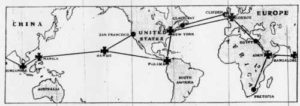
Page updated January 2, 2004 Page created October 23, 2000
We Need Your Help! Volunteer with Us.
Join our mission to preserve historic Camp Evans and teach the public about science and history.
Sign up to join our team of volunteers and start on your own mission today.
InfoAge Science & History Museums
2201 Marconi Road
Wall, NJ 07719
Tel: 732-280-3000
info@infoage.org
webmaster@infoage.org
